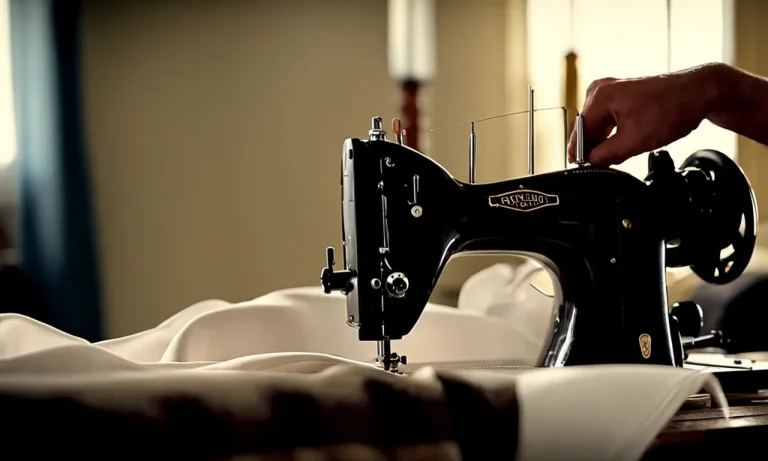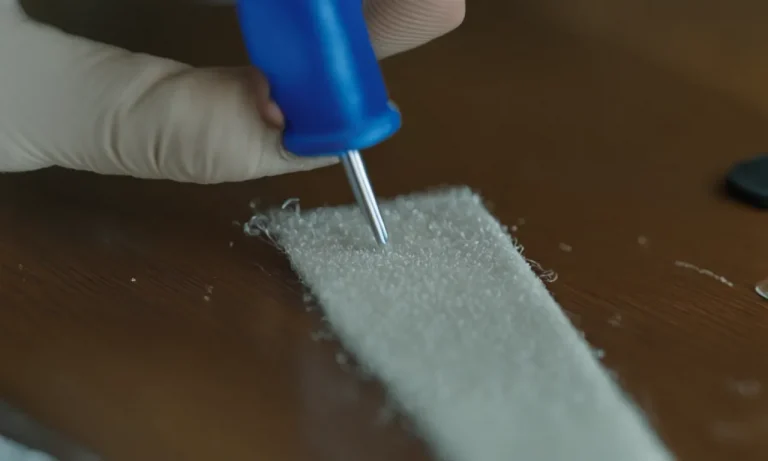How To Oil A Singer Sewing Machine For Optimal Performance
Sewing machines, like other mechanical devices, require regular oiling and lubrication to keep everything running smoothly. For those who own a Singer brand sewing machine, oiling it properly is key to keeping it in top working order.
If you’re short on time, here’s a quick answer to your question: Use sewing machine oil and apply a few drops to all moving parts like the shuttle, bobbin case, presser foot, and handwheel. Read the manual for specific directions.
But for optimal performance and longevity of your machine, following the steps below for a more thorough oiling is recommended.
In this comprehensive guide, we will cover everything you need to know about oiling your Singer sewing machine model. From understanding why oiling is needed in the first place, what types of oils to use, what parts need lubrication, how often to oil, and step-by-step instructions and tips – we’ve got you covered.
Why It’s Important to Oil a Sewing Machine
Regularly oiling your Singer sewing machine is crucial for maintaining its optimal performance and longevity. By lubricating the moving parts, you can reduce friction and wear, prevent rust and corrosion, and keep the machine running smoothly.
Reduces Friction and Wear
When you use your sewing machine, the metal parts rub against each other, causing friction. Over time, this friction can lead to wear and tear, resulting in decreased efficiency and potential damage to the machine.
By applying oil to the moving parts, you create a protective barrier that reduces friction and helps the machine operate smoothly. This not only improves the overall performance but also prolongs the lifespan of your sewing machine.
Prevents Rust and Corrosion
Moisture, humidity, and dust can cause rust and corrosion on the metal components of your sewing machine. Rust can interfere with the smooth movement of parts and cause them to seize up. Regular oiling forms a protective layer on the metal surfaces, preventing moisture from penetrating and minimizing the risk of rust and corrosion.
By keeping your machine free from these issues, you ensure its longevity and avoid costly repairs.
Keeps Machine Running Smoothly
Without proper lubrication, your sewing machine may start to make strange noises or operate less smoothly. This can affect the quality of your stitches and make sewing more challenging. By oiling the machine regularly, you ensure that all the moving parts work together seamlessly, resulting in smooth and precise stitching.
It also helps in reducing the chances of thread breakage and skipped stitches, allowing you to enjoy a hassle-free sewing experience.
It’s important to follow the manufacturer’s instructions for oiling your Singer sewing machine. Different models may require different types of oil and specific lubrication points. Make sure to clean the machine thoroughly before applying oil to remove any lint or debris that may hinder its performance.
For more detailed information on how to oil your Singer sewing machine, you can visit the official Singer website singer.com. They provide comprehensive guides and tutorials to assist you in maintaining your sewing machine and ensuring its optimal performance.
How Often to Oil a Singer Sewing Machine
Proper maintenance is essential to keep your Singer sewing machine running smoothly and efficiently. One crucial aspect of maintenance is oiling the machine regularly. Oiling helps to reduce friction, prevent rust, and ensure optimal performance.
The frequency of oiling a Singer sewing machine depends on various factors, such as the age of the machine and how often it is used.
New Machines: After First 8-10 Hours of Use
For brand new Singer sewing machines, it is recommended to oil them after the first 8-10 hours of use. This initial oiling is crucial to ensure that all the internal parts are properly lubricated. The user manual provided with your machine will have specific instructions on how to oil it correctly.
Following these guidelines will help you maintain the machine’s warranty and extend its lifespan.
Older Machines: Every 4-6 Weeks of Regular Use
If you have an older Singer sewing machine that has been in use for a while, it is important to oil it more frequently. Generally, older machines should be oiled every 4-6 weeks, depending on how often they are used.
Regular oiling will help prevent the parts from seizing up and keep the machine running smoothly. Remember to follow the manufacturer’s instructions and use the recommended sewing machine oil.
After Long Periods of Non-Use
If your Singer sewing machine has been sitting idle for an extended period, such as several months or more, it is essential to oil it before using it again. Long periods of non-use can cause the internal parts to dry out and become stiff.
Oiling the machine will help to restore the lubrication and ensure proper functionality. Be sure to clean the machine thoroughly before oiling to remove any dust or debris that may have accumulated.
Remember, regular oiling is key to keeping your Singer sewing machine in top condition. It is always better to oil more frequently than not enough, as proper lubrication is crucial for optimal performance.
If you are unsure about the oiling process or have any concerns, it is recommended to consult the manufacturer’s website or contact their customer support for guidance.
What Oil to Use on a Singer Sewing Machine
Light Sewing Machine Oil
When it comes to oiling a Singer sewing machine, it is important to use the right type of oil. The most recommended oil for Singer sewing machines is a light sewing machine oil. This type of oil is specifically formulated for sewing machines and is designed to provide optimal lubrication for the machine’s moving parts.
Light sewing machine oil is lightweight and non-greasy, allowing it to easily penetrate and lubricate the small components of the machine. It helps reduce friction and wear, ensuring smooth operation and extending the lifespan of your Singer sewing machine.
Avoid Using Household Oils
While it may be tempting to use household oils as a substitute for sewing machine oil, it is highly advised against doing so. Household oils such as cooking oil, motor oil, or WD-40 are not suitable for sewing machines.
These oils are too thick and can leave residue, leading to clogging and damaging the delicate mechanisms of the machine. Additionally, household oils may not provide adequate lubrication, resulting in poor performance and potential damage to your Singer sewing machine.
It is important to note that using the wrong type of oil on your Singer sewing machine can void its warranty and cause irreversible damage. Therefore, it is always best to use the recommended light sewing machine oil for optimal performance and longevity.
What Parts to Oil on a Singer Sewing Machine
Properly oiling your Singer sewing machine is crucial for maintaining its optimal performance. By lubricating the right parts, you can ensure smooth operation and prevent unnecessary wear and tear. Here are the key areas to focus on when oiling your Singer sewing machine:
Shuttle and Bobbin Area
The shuttle and bobbin area is one of the most critical parts to oil in a Singer sewing machine. This area houses the mechanisms responsible for creating stitches. To ensure smooth stitching, apply a few drops of sewing machine oil to the shuttle race and the bobbin case.
This will reduce friction and keep the parts moving effortlessly.
Feed Dogs and Needle Bar
The feed dogs and needle bar are also important components that require regular oiling. The feed dogs are responsible for moving the fabric through the machine, while the needle bar controls the up and down motion of the needle.
Apply a small amount of oil to the feed dog mechanism and the needle bar pivot points. This will help the fabric glide smoothly and prevent any jerky movements.
Presser Foot and Attachments
The presser foot and its attachments play a vital role in holding the fabric in place during sewing. To ensure their smooth operation, apply a drop of oil to the presser foot hinge and any movable parts.
This will prevent any stiffness and allow the presser foot to move up and down effortlessly, resulting in neat and even stitches.
Handwheel and Gears
The handwheel and gears are responsible for controlling the movement of various machine parts. To keep them running smoothly, apply a small amount of oil to the handwheel’s axle and the gears. Be careful not to over-oil, as excess oil can attract lint and dust.
A well-lubricated handwheel and gears will ensure the machine runs quietly and efficiently.
Remember, when oiling your Singer sewing machine, it’s important to use sewing machine oil specifically designed for this purpose. Avoid using household oils, as they can leave residue and cause damage to the machine.
Always refer to your machine’s manual for specific instructions on oiling and maintenance.
For more detailed information on oiling your Singer sewing machine, you can visit the official Singer website at www.singer.com.
Step-by-Step Instructions for Oiling a Singer Sewing Machine
Gather Your Supplies
Before you begin oiling your Singer sewing machine, make sure you have all the necessary supplies on hand. You will need:
- A high-quality sewing machine oil
- A clean, lint-free cloth
- A small brush or q-tip
Having these supplies ready will ensure a smooth and efficient oiling process.
Wipe Away Dust and Residue
Prior to oiling, it’s important to clean your sewing machine to remove any dust or residue that may have accumulated. Use a clean cloth to gently wipe down the machine, paying close attention to the areas around the needle, bobbin, and feed dogs.
This will prevent any dirt or debris from getting into the oil ports.
Locate Oil Ports
Next, you’ll need to locate the oil ports on your Singer sewing machine. These ports are small holes or slots where the oil is applied to keep the moving parts lubricated. Consult your sewing machine’s manual or visit the Singer website www.singer.com for specific instructions on where to find the oil ports on your model.
Apply Oil to Moving Parts
Once you have located the oil ports, it’s time to apply the oil. Take a small amount of sewing machine oil and carefully apply it to the moving parts of your Singer sewing machine. Be sure to follow the instructions in your manual for the correct amount of oil to use and where to apply it.
Use a small brush or q-tip to reach any hard-to-reach areas.
Remove Excess Oil
After applying the oil, it’s important to remove any excess to prevent it from staining your fabric or causing buildup. Use a clean cloth to wipe away any excess oil from the surface of the machine. Be thorough but gentle to avoid damaging any delicate parts.
Test and Adjust Tension
Once you have completed the oiling process, it’s a good idea to test your Singer sewing machine to ensure it is working properly. Thread the machine and sew a few stitches on a scrap piece of fabric. Check the tension and adjust as needed to achieve the desired stitch quality.
If you notice any issues, consult your sewing machine manual or contact Singer customer support for further assistance.
By following these step-by-step instructions, you can properly oil your Singer sewing machine and ensure optimal performance for all your sewing projects. Remember to regularly oil your machine to keep it running smoothly and extend its lifespan.
Tips for Keeping Your Singer Sewing Machine Well Oiled
Proper lubrication is essential for maintaining the performance and longevity of your Singer sewing machine. Regular oiling helps to reduce friction, prevent rust, and keep the machine running smoothly. Here are some useful tips to ensure that you oil your Singer sewing machine correctly:
Refer to Your Instruction Manual
Before you start oiling your Singer sewing machine, it is crucial to consult the instruction manual. Each model may have specific oiling requirements, and the manual will provide you with detailed instructions on where and how to oil your machine.
It is essential to follow these instructions carefully to avoid any potential damage.
Use a Straw or Nozzle for Hard to Reach Areas
Some parts of your Singer sewing machine may be difficult to access for oiling. To overcome this challenge, you can use a straw or a nozzle attachment to direct the oil precisely where it is needed. This will help you reach tight spots, such as the bobbin area or the needle bar, ensuring that all essential components are adequately lubricated.
Avoid Over-Oiling
While oiling your Singer sewing machine is essential, it is equally important not to overdo it. Excessive oil can attract dust and lint, leading to clogs and other issues. Follow the recommended oiling intervals mentioned in your instruction manual, and apply only the amount of oil specified.
This will help maintain the machine’s optimal performance without causing any harm.
Let Oil Settle Before Sewing
After oiling your Singer sewing machine, it is crucial to give the oil some time to settle before you start sewing. This allows the oil to penetrate the moving parts and provide effective lubrication. A general recommendation is to wait for about 10-15 minutes before resuming sewing.
This small waiting period ensures that the oil is evenly distributed and ready to enhance the machine’s performance.
By following these tips, you can ensure that your Singer sewing machine receives proper oiling, leading to optimal performance and longevity. Remember to consult your instruction manual for specific guidelines, and enjoy your sewing experience with a well-maintained machine!
Conclusion
By now you should have a thorough understanding of the importance of oiling your Singer sewing machine, what oil to use, where and how often to lubricate, and tips for keeping everything running smoothly.
Following proper oiling procedures will keep your machine running like new for years of crafting and sewing enjoyment. Be sure to consult your specific model’s manual as well for additional oiling directions. Happy sewing!







